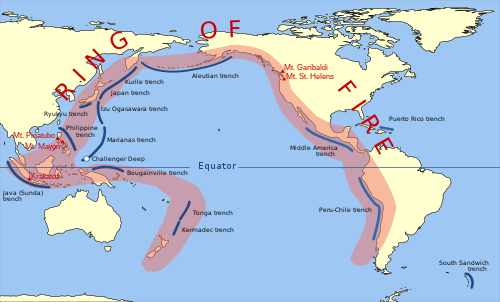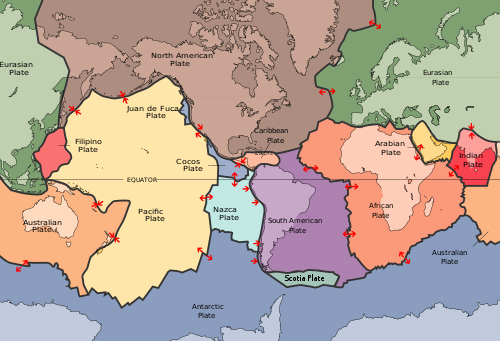Japan sits atop deadliest section of Ring of Fire
PAUL WALDIE | The Globe and Mail | Friday, Mar. 11, 2011 9:54PM EST
The recent earthquakes that have pounded Japan, New Zealand and Chile all have one thing in common: They were caused by the movement of a massive piece of Earth known as the Pacific Plate.
The Pacific Plate is one of nine giant tectonic plates that cover the Earth’s surface. But it’s bigger, faster and more deadly than the others. And Japan sits right on top of the most active section.

from Wikipedia:
The Pacific Ring of Fire is an area where large numbers of earthquakes and volcanic eruptions occur in the basin of the Pacific Ocean. In a 40,000 km (25,000 mi) horseshoe shape, it is associated with a nearly continuous series of oceanic trenches, volcanic arcs, and volcanic belts and/or plate movements. The Ring of Fire has 452 volcanoes and is home to over 75% of the world's active and dormant volcanoes. It is sometimes called the circum-Pacific belt or the circum-Pacific seismic belt.
About 90% of the world's earthquakes and 80% of the world's largest earthquakes occur along the Ring of Fire... The Ring of Fire is a direct result of plate tectonics and the movement and collisions of crustal plates.
more @Wikipedia

Plate tectonics
from Wikipedia:
These plates move in relation to one another at one of three types of plate boundaries: convergent, or collisional boundaries; divergent boundaries, also called spreading centers; and conservative transform boundaries. Earthquakes, volcanic activity, mountain-building, and oceanic trench formation occur along these plate boundaries....
Tectonic plates are able to move because the Earth's lithosphere has a higher strength and lower density than the underlying asthenosphere. Lateral density variations in the mantle result in convection. Their movement is thought to be driven by a combination of the motion of seafloor away from the spreading ridge (due to variations in topography and density of the crust that result in differences in gravitational forces) and drag, downward suction, at the subduction zones. A different explanation lies in different forces generated by the rotation of the Globe and tidal forces of the Sun and the Moon. The relative importance of each of these factors is unclear, and is still subject to debate.
more @Wikipedia
No comments:
Post a Comment